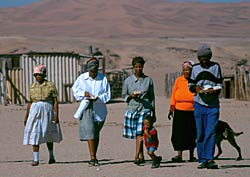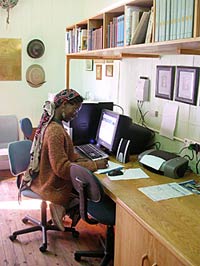|
Reaching Coastal Communities - How Radio can Make a Difference |
 The 4000 kilometers of coastal area that is flanked by the Benguela Current consists of a number of diverse communities that depends to different extents on the natural resources that this ecosystem has to offer. Because of these communities “collective” reliance on the coastal resources, one can argue that a collective management approach from all beneficiaries is essential. However, the effective participation in the collective management of our coast depends on how well informed the communities are? The 4000 kilometers of coastal area that is flanked by the Benguela Current consists of a number of diverse communities that depends to different extents on the natural resources that this ecosystem has to offer. Because of these communities “collective” reliance on the coastal resources, one can argue that a collective management approach from all beneficiaries is essential. However, the effective participation in the collective management of our coast depends on how well informed the communities are?
It is a fact that the communities along this coastline are geographically isolated. This isolation makes it a somewhat difficult task to engage communities in the management of their coast and resources. How will the two way flow of information dissemination be facilitated? The birth of Information and Communication Technology (ICTs), have somewhat faded this isolation through innovations such as computer technology, internet and radio. ICT therefore provides a mechanism through which information can be shared. DLIST as a project, initially facilitated information sharing only through its online platform, however, this approach had its limitations. Not all coastal communities have the infrastructural capacity of computers and internet. Efforts were made to address this limitation by establishing nodes along the coastal areas.
 The purpose of the nodes was to bring DLIST closer to the communities by a establishing a focal point where information could be easily accessed. The node was run by a local focal person who engaged the community and linked the them to the wide network of DLIST. This approach had its limitations as well, since it is not one of the conventional information sharing mechanisms for many communities. As a result, an assessment to bring in Radio into the equation was designed. After a few pilots with the National Broadcasting Corporation in Namibia, Radio has proved to be an ideal medium for disseminating information. The purpose of the nodes was to bring DLIST closer to the communities by a establishing a focal point where information could be easily accessed. The node was run by a local focal person who engaged the community and linked the them to the wide network of DLIST. This approach had its limitations as well, since it is not one of the conventional information sharing mechanisms for many communities. As a result, an assessment to bring in Radio into the equation was designed. After a few pilots with the National Broadcasting Corporation in Namibia, Radio has proved to be an ideal medium for disseminating information.
The idea was to bring forth radio programming aimed at sharing information and ideas on pertinent environmental issues affecting people in their respective regions. For each radio discussion/broadcast local experts were invited to converse about a specific topic. Not only did the local experts explain information in local languages, but they also contextualized it hence making it relevant to local circumstances. Where possible more than one guest was invited in order to offer a different perspective to the listeners, or to translate the content into an additional local language. These radio programmes were structured in the form of panel discussions with people phoning in to participate in the discussions.
In our experience, these programmes have assisted in developing the public’s awareness and understanding of local environment problems, through a diversity of informative discussions. It also provides a medium of expression for local communities.
Radio has proved to be one of the applicable means of communication and a channel through which most people along the coastal areas receive their information. A good and interactive programme is one that answers to local needs. One important lesson was to assess what issues are important for communities and to develop content based on this need. Involving community members in developing content as well as during broadcast as guest speakers is important in creating a sense of ownership of the programmes - making these programmes by the community for the community.
|